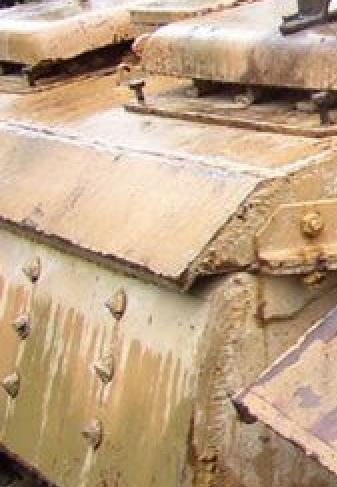This is the COOLEST! A wholly and well-preserved StuG!
I think that this thing should certainly be informative and instructive to armour modelers in regards to chipping and weathering!
The paint is very interesting:
Looks to me like there are two very distinct things going on- a notable minimum amount of wear at the most-exposed points (crowns of hinges, edges of hatches and plate-joins, etc.- places where there was likely frequent contact with and abrasion from boots and people and stuff dragging around, etc.), and a rather heavy randomized and shot-gun flaking of mostly flat plate surfaces - a flaking which appears to expose intact primer.
The minimum corner and edge wear suggests not much had occurred before this thing got buried.
The appearance seems to differ between the two sets of blems... that's the real informative part, I think: the worn hinge-crowns and other exposed hi-points look like the wear seen on construction equipment and on modern armor (a great place to see wear on the general class of objects), and on handled models (which actually wear and soil on the hi-points, and probably constitute "good models" of "the real thing" in more ways than one!). I would offer that looking closely at these wear-points would be most instructive for showing wear on builds- where does it occur, how much occurs, and what do the worn spots look like... like, it does extend down thru the primer and expose the metal (dark- not heavily-rusted)?
The chips on flat plates clearly show simple "passive" (non-abraded) flaking of the paint. They look much like paint flaking off of a wall where someone has simply slapped another layer on over a poorly-prepped surface. The new coat WILL flake. Paint will crack and lift as its adhesion fails. The prior painted surface will be exposed... in this case, appears to be primer.
As to the storage environment... a peat-bog is essentially anoxic, low-pH and substantially laden with organic acids- "tannins". These tannins are the sorts of chemistry used to "tan" skins and hides to make leather. A stabilizer of proteins and debilitator of most bacterial action, among other things. Bogs are also wet.
Even good paint well-applied will fail after many years of emersion in mild acid solutions- any small hole or imperfection in the surface will allow the acid solution (bog water) to seep beneath, break the adhesion, and lift the paint. Same thing as happens to the sides of your well-painted house- even the finest house exterior paints will eventually lift- the surface is NEVER perfectly-sealed. So, I would expect the general paint surface to start flaking after 60+ years of swimming!
As others have noted, a lot of this flaking (as distinct from the clearly-abraded bits) is on the flat surfaces. The question may be "why not equally or more so flaked on those exposed points?" This evident pattern may well reflect another interesting (to me, anyway!) aspect of the vehicle .... the hinges and corners and castings and weld-lines may offer better adhesion surfaces than do some flat plates- the rolled plates will be smoother and offer less texture for paint to bite on to.
This pattern of flaking more on flats and pressed surfaces versus on castings and weld-beads and the like is consistent with that often seen in industrial and other equipment, and has plagued the car industry for almost a century - where final coats appear to flake off the primer coat beneath.
Metals are primed to provide uniform surfaces for other paints to consistently adhere to. As the flaking here has revealed primer, the failure is NOT in the primer adhesion to the metal, but rather in the outer paint coat adhesion to the primer surface.
More paint flaking off flats would be consistent with a model where primer surface quality is even all over, but the additional structural (metal) texture varies between smooth flats and rougher welds, castings, etc. These latter rougher areas should retain paint longer than flats will, given equal priming.
So, to me, Mr. Preserved StuG shows BOTH modest actual wear and tear AND the effects of general surficial paint failure after 60+ years of emersion!
Bob


















































